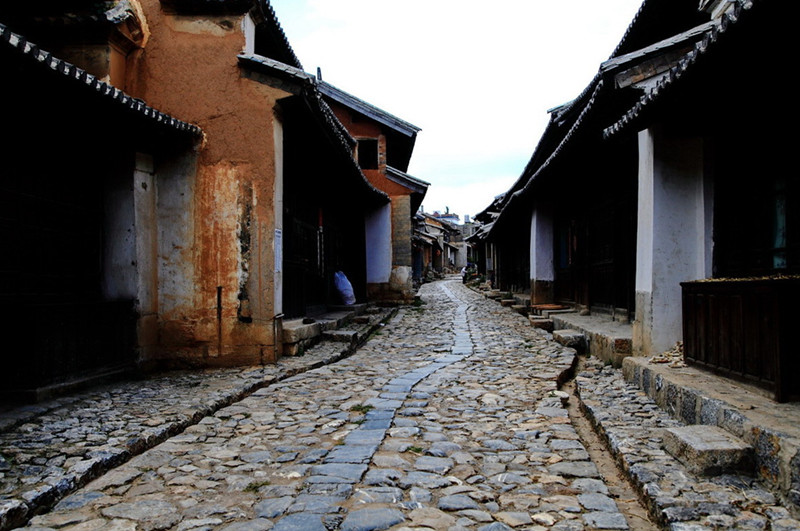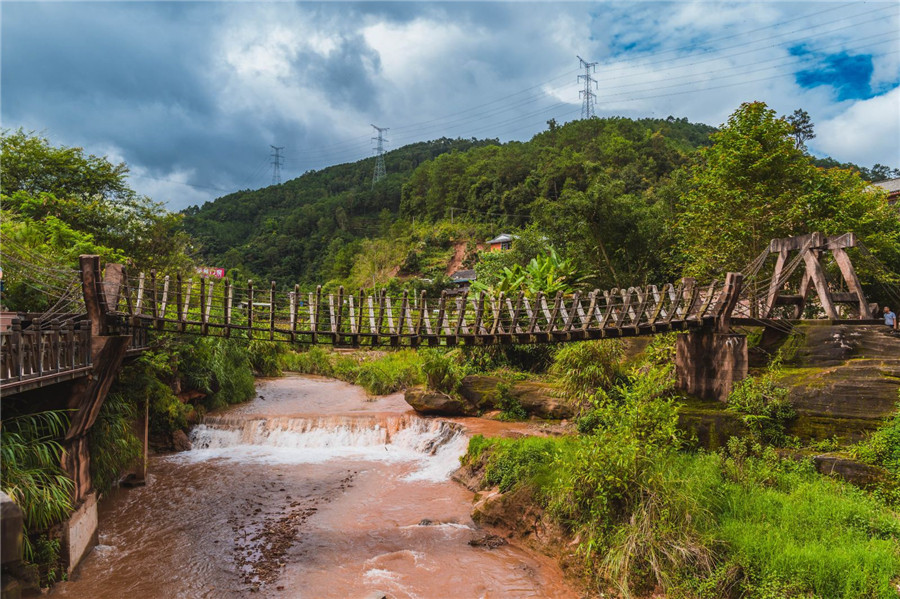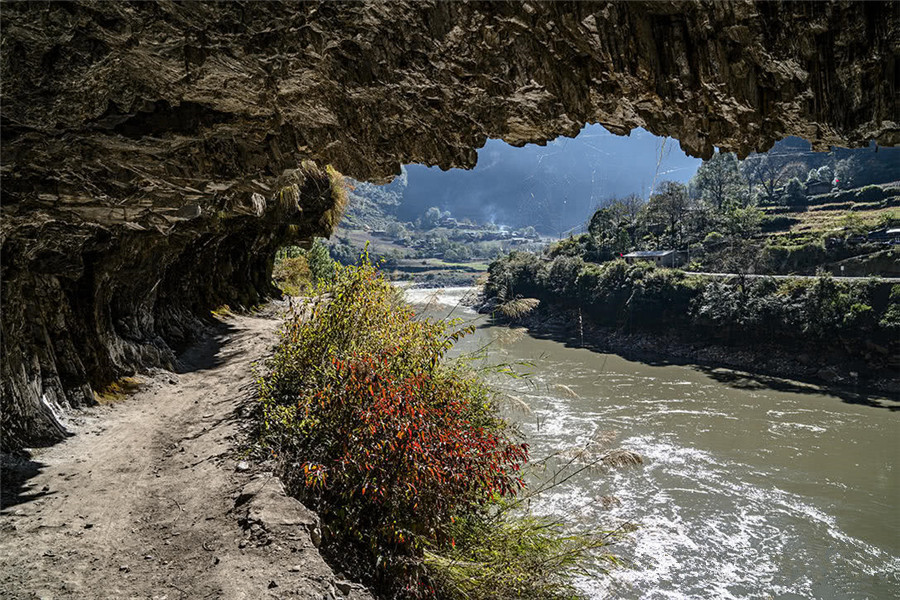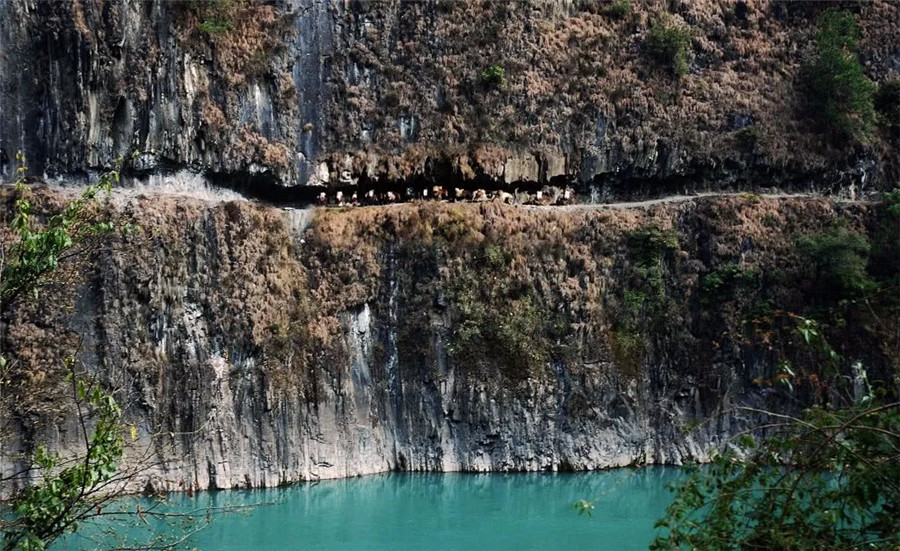
The Ancient Tea Horse Road in China
The Tea Horse Road or chamadao (simplified Chinese: 茶马道; traditional Chinese: 茶馬道), now generally referred to as the Ancient Tea Horse Road or chamagudao (simplified Chinese: 茶马古道; traditional Chinese: 茶馬古道) was a network of caravan paths winding through the mountains of Sichuan, Yunnan and Tibet in Southwest China. This was also a tea trade route. It is also sometimes referred to as the Southern Silk Road or Southwest Silk Road, and it is part of a complex routes system connecting China and South Asia.
There are numerous surviving archaeological and monumental elements, including trails, bridges, way stations, market towns, palaces, staging posts, shrines and temples along the route. Besides the route’s importance for commercial activity, more significantly it was crucial for cultural exchange between the Indian subcontinent, Tibet and Southwest China. Especially, it was vitally important for the interchange of Buddhism between China and South Asia.
The Ancient Tea Horse Road, also known as Chamadao (茶马道) or Chamagudao (茶马古道), was a historic network of caravan routes that traversed the rugged mountains of Southwest China, connecting the tea-producing regions of Sichuan, Yunnan, and Tibet. This trade route, also known as the “Southern Silk Road” or “Southwest Silk Road,” played a vital role in the exchange of tea, horses, and other goods between China and its neighbors.

The Ancient Tea Horse Road (茶马古道, Chá Mǎ Gǔ Dào) is a historically significant network of caravan paths that linked the regions of Southwest China with Tibet, Southeast Asia, and even South Asia. It played a crucial role in the economic, cultural, and social exchanges between different ethnic groups and regions. Check more about The History of The Ancient Tea Horse Road.
Origins and Development
- Early Beginnings:
- The origins of the Tea Horse Road can be traced back to the Tang dynasty (618–907 AD) when the Tibetan Empire required horses for its cavalry and sought tea from the Han Chinese to satisfy the growing tea consumption among its people. The road’s importance grew during the Song (960–1279) and Yuan (1271–1368) dynasties, as the demand for horses and tea became even more critical.
- Main Goods Traded:
- Tea: The road is most famous for the trade of tea, particularly from the Yunnan and Sichuan provinces. The tea was transported in compressed bricks or other forms that were easier to carry over long distances.
- Horses: In exchange for tea, Tibetans would trade horses, which were essential for the Chinese military and agricultural purposes.
- Other goods traded included salt, sugar, textiles, spices, herbs, and various local products.
Geography and Routes
- Main Routes:
- The Tea Horse Road was not a single path but a network of routes that passed through various provinces in China, including Yunnan, Sichuan, and Tibet. These routes extended into Myanmar, India, Nepal, and beyond.
- Yunnan-Tibet Route: Starting from Pu’er and Lijiang in Yunnan Province, this route was the most famous. It crossed through the Hengduan Mountains, reaching Tibet and further to South Asia.
- Sichuan-Tibet Route: Originating from Sichuan Province, this route also connected to Lhasa and other parts of Tibet.
- Terrain and Challenges:
- The routes traversed some of the most challenging terrains in the world, including high mountain passes, deep river gorges, dense forests, and snow-capped peaks. The caravan traders, known as mabang (horsemen), faced extreme weather conditions, bandit attacks, and the risk of falling into ravines.
Cultural and Historical Significance
- Cultural Exchange:
- The road facilitated significant cultural exchange between the Han Chinese, Tibetans, Bai, Naxi, and other ethnic groups. This interaction led to the exchange of ideas, religious beliefs (especially the spread of Buddhism), art, and language.
- Historical Impact:
- The Tea Horse Road was instrumental in maintaining the political and economic balance between the Chinese empire and Tibet. The trade of tea and horses was not only a matter of commerce but also of diplomacy and strategy, influencing the relations between the regions.
- Preservation and Decline:
- The road’s use began to decline with the advent of modern transportation and political changes in the 20th century. However, its historical importance has led to efforts to preserve the remnants of this ancient trade route. In 2013, the Tea Horse Road was listed as part of the national key cultural relic protection units in China.
The ancient Tea Horse Road was a network of caravan paths winding through the mountains of southwest China. It was used as a commercial passage for transporting tea, salt and other commodities. Sometimes Chinese tea would be exchanged for Tibetan ponies. Historically, the ancient Tea Horse Road was almost the same as the western frontier of China.
Historical Significance
The Ancient Tea Horse Road was instrumental in fostering trade and cultural exchanges between Han Chinese and Tibetan regions from the Tang and Song Dynasties (618–1279 AD) until the early 20th century. The road was named for the trade of Chinese tea for Tibetan horses, a practice essential for China’s defense against northern nomads. The sturdy Tibetan ponies were highly valued by the Chinese military, making this trade crucial.
Major Routes
- Shaanxi-Gansu Tea Horse Road (陕甘茶马古道): This route was the primary passage for tea from mainland China to the west, exchanging tea for horses. It was an essential component of the broader Silk Road network.
- Tanggu Road (蹚古道): Originating during the Han dynasty, this route was significant for the tea trade in the southwest frontier. It connected Shaanxi merchants with the tea-horse markets, particularly flourishing during the Ming and Qing dynasties.
- Yunnan-Tibet Tea Horse Road (滇藏茶马古道): Formed in the late sixth century, this route began in the tea-producing areas of Yiwu and Pu’er in Yunnan, passing through Dali, Lijiang, and Shangri-La before reaching Lhasa in Tibet. Some goods were further re-exported to India and Nepal, making it an important trade link between China and South Asia.
- Sichuan-Tibet Tea Horse Road (川藏茶马古道): This route started in Ya’an, Sichuan, and extended to Lhasa, eventually reaching Bhutan, Nepal, and India. It was part of the larger Shaanxi-Kangding-Tibet Tea-Horse Road, acting as a critical bridge between Tibet and mainland China.
Cultural and Archaeological Heritage
The Ancient Tea Horse Road is rich in archaeological and cultural heritage. Along the route, numerous relics such as trails, bridges, market towns, staging posts, temples, and shrines have survived. These sites offer a glimpse into the vibrant trade and cultural exchanges that occurred over centuries.
Historic Sites in Sichuan
Sichuan Province, one of the key regions on the Ancient Tea Horse Road, boasts a variety of historic sites, including:
- Pingle Longshan Ancient Road in Qionglai City, part of the South Silk Road Ruins Scenic Area.
- Huicaikou Ancient Salt Road in Zigong, showcasing the region’s historical significance in salt production and trade.
- Guanyin Tower in Ya’an, reflecting the area’s rich cultural and religious history.
- Qingxi Pass Site of Tang Dynasty in Hanyuan County, an ancient military and trade post.
Historic Sites in Yunnan
Yunnan Province, with 86 cultural heritage sites related to the Ancient Tea Horse Road, includes:
- Yunnanyi Ancient Road in Xiangyun County, a well-preserved section of the road.
- Tiger Pass to Puchang River Section of the Ancient Post Road in Xiangyun County, demonstrating the road’s strategic importance.
Trade and Cultural Exchange
The road was not only a trade route but also a cultural conduit, facilitating the spread of tea culture from Yunnan to Tibet and beyond. The tea carried on this route, often in the form of tea bricks, was a staple in Tibetan diets, consumed with yak butter and salt. In return, Tibet sent horses, medicinal herbs, wool, and other goods back to China.
Porters along the route often carried heavy loads, sometimes exceeding their body weight. They were equipped with metal-tipped staffs to maintain balance and support their loads during rest. These journeys were arduous and dangerous, with traders braving treacherous mountain passes and inclement weather.
Legacy
Today, the Ancient Tea Horse Road is recognized as a significant cultural and historical relic. Some sections of the road and related sites have been designated as China National Key Cultural Relics Protection Units. The route’s legacy continues to be celebrated in modern China as a symbol of the historical ties between the Han Chinese and Tibetan peoples, as well as the broader connections between China and South Asia.
The Ancient Tea Horse Road remains a testament to the enduring power of trade and cultural exchange, and its historical significance is preserved through ongoing archaeological efforts and cultural preservation initiatives.
The Ancien Tea Horse Road in Yunnan
The Ancient Tea Horse Road in Yunnan, a vital trade route in Yunnan province, is dotted with 86 cultural heritage sites spread across 21 counties and cities. Below is a summary of some key locations:
Xiangyun County
- Yunnanyi Ancient Road (Yunnanyi Town): Located at 25°25′29″N 100°41′26″E.
- Xiaoshao to Huangcaoshao Ancient Road (Midian Town).
- Baisha Slope to Yongan Bridge Ancient Road (Midian Town).
- Tiger Pass to Puchang River Section (Midian Town).
- Xincun to Binchuan South Boundary Monument Section (Xiangyun Town).
- Zhenyang Gate (Gulou East Street, Xiangcheng Town): Positioned at 25°28′45″N 100°33′34″E.
Yangbi Section
- Dahe River Street Section (Pingpo Town): 240 meters long.
- Liziyuan to Dam Field Section (Pingpo Town): 550 meters, includes Voucher Bridge.
- Jinniu Village Mud Pass Section (Cangshan West Town): 100 meters long.
- County Bonan Section (Cangshan West Town): 900 meters long.
- Shuangmo Lane, Xiajie Village (Cangshan West Town): 400 meters long.
Yongping Section
- Jiaogou Mount Section (Yongping County).
- Wanma Guichao Section (Bonan Town): 140 meters long.
- Iron Works to Little Flower Bridge (Yongping County): 1600 meters long.
- Dahuajiao Section (Yongping County).
- Bonan Mount Section (Yongping County).
- Shanyang Old Street Section (Yongping County).
Midu Section
- Yonghe Village (Mizhi Town): Located at 25°10′03″N 100°31′21″E.
Heqing Xiangmian Mountain Section
- Located in Heqing County, Songgui Town, Jindun Township.
Jianchuan Section
- Located in Shaxi Town, Jianchuan County at 26°19′12″N 99°51′03″E.
Simao Section
- Caiyang River Section (Yutang Village Committee, Yixiang Town, Simao District).
- Jiejipo Section (Simao District).
Ning’er Section
- Cha ‘an Tang Ancient Road (Ning’er County): Starts at Minzhu Village, ends at Xingguang Village.
- Korie Tea Horse Road (Ning’er County): 4.38 km long.
- Peacock Screen Tea Horse Ancient Road (Ning’er County): 27 km long.
Yulong County
- Seventy-Two Lines (Taian Township, Longpan Township).
Shangri-La City
- Twenty-Four Turn Sections: 38 km long in Tiger Leaping Gorge.
- Twelve Rail Section: 8 km long in Tiger Leaping Gorge Township.
Longyang District, Baoshan City
- Shui Shi Kan Terraced Cloud Road (Shuizhai Village, Shuizhai Township).
- Guanpo Ancient Road Flagstone Road (Guanpo Village).
- Shek Ma Shan to Wu Tau Tong Ancient Road (Qinggangba Village, Hanzhuang Town).
- Old Stone Path of the Seventy-Six Roads in Lingshui Turnip (Shuijing Village).
- Gaoligong Mountain Beizhai Public House Dongpo Ancient Road.
- Gaoligong Mountain Nanzhai Public House Dongpo Ancient Road.
- Ancient Eastern Slope Trail at Dafengkou.
Tengchong Section
- Beizhai Public House West Slope Ancient Road Flagstone Road (Jietou Town, Tengchong City): Positioned at 25°32′39.1″N 98°45′33.4″E.
- Chengmen Cave West Slope Ancient Stone Road (Mangba Town, Tengchong City): Positioned at 24°56′00.8″N 98°44′41.5″E.
Longchuan County
- Shanmu Longshan North Slope Ancient Road (Huiguo Township): 5 km long, 3.2 km extant.
- Fir Cage Shanxi Slope Ancient Road (Huiguo Township).
Lianghe County
- Maofu Ancient Road Flagstone Road (Maofu Village, Jiubao Township): Positioned at 24°47′43″N 98°11′56″E.
Deqin County
- A Dunzi Section.
- Meili Section.
Lijiang Ancient City District
- Qiu Tang Guan Tea Horse Ancient Road Section.
- Shuhe Tea Horse Ancient Road Section.
- Horseshoe Print Stone Path.
Yuan County, Puer Town
- Ruins of Guang’en Bridge (Minjiang Village, Enle Town).
- Stone Carving of the Passing Gate at Xiaoshuijing Liangzi.
- Ancient Tea and Horse Route in the Wailing Mountains.
These ancient routes reflect the rich cultural and historical significance of the Tea Horse Road in Yunnan.
The Ancient Tea Horse Road in Sichuan
The Ancient Tea Horse Road, or Chamadao, in Sichuan is rich with historical sites, reflecting the vibrant history of trade and cultural exchange that took place along this ancient route. Below is an overview of notable locations along the Tea Horse Road in Sichuan, categorized by their respective regions:
Chengdu Area
- Pingle Longshan Ancient Road: Located in Pingle Town, Qionglai City, within the South Silk Road Ruins Scenic Area.
- Shuanmaling Ancient Road, Linji: Situated in Linji Town, Qionglai City.
- Tiantai Mountain Eart Stream, Zijing Village Ancient Road: Found in Tiantaishan Town, Qionglai City.
- Jiaguan Gongdian Ancient Road: Located in Jiaguan Town, Qionglai City.
- Site of Ancient Fire (Salt) Well of Oil Press: Situated in Huojing Town, Qionglai City.
- Lining Waist Rock Tea Horse Ancient Road: Located in Chaoyanghu Town, Pujiang County. The pathway runs from the old pine tree on the top of the lined waist rock to the ancient pathway on the shore of Changtan Lake, stretching 470 meters.
- Songmau Ancient Road (Lung Chi Section): Found in Longchi Town, Dujiangyan City.
Zigong Area
- Lok Shan Square: Located in the Ziliujing District.
- Huicaikou Ancient Salt Road: Also in the Ziliujing District.
- Mugye Beach Pier: Situated in the Gongjin District, consisting of two piers built during the Kangxi and Guangxu eras of the Qing Dynasty.
- Gong Jing Old Street Salt Road: Located in the Gongjin District.
- Salt Wharf in Xian Town: Found in the Yantan District.
Luzhou Area
- Guangming Ancient Road: Located in Fuzi Town, Lu County. The road runs southeast-northwest with a length of 1,091 meters and a width of 1.7 to 2.9 meters.
- Pauline Street Post Road: Situated in Longmatan District with a length of 810 meters.
- Shawan Post Road: Found in Jiangyang District.
- Fengming Post Road: Located in Hejiang County.
- Bailu Post Road: Also in Hejiang County.
- Xiantan Ancient Post Road: Found in Hejiang County.
- Dashichuanqian Post Road: Situated in Xuyong County.
- Monkey Ridge Chuanqian Post Road: Also in Xuyong County.
- Guandou Village Chuanqian Post Road: Located in Xuyong County.
- Chishui River Tea Horse Post Road: Found in Xuyong County.
- Erlang Post Road: Situated in Gulin County.
Ya’an Area
- Guanyin Tower: Located in Yucheng District.
- Jingju Nunnery Stone Archway: Found in Mingshan District.
- Yu Palace: Also in Mingshan District.
- Ganlu Ling Quan Courtyard Stone Archway: Situated in Mingshan District.
- Imperial Tea Garden: Located in Mingshan District.
- Tianti Ancient Path: Found in Mingshan District.
- Ganxipo Tea Horse Ancient Road Post Site: Situated in Tianquan County.
- Bian Tea Official Warehouse: Located in Tianquan County.
- Feixian Pass and South Boundary Archway: Found in Lushan County.
- Saddle Waist Cliff Inscription: Located in Lushan County.
- Rebuild the Road Monument of Daxiangling Bridge: Situated in Xingjing County.
- The Site of Gongxing Tea from the Qing Dynasty: Also in Xingjing County.
- Qingxi Pass Site of Tang Dynasty: Found in Hanyuan County.
- Ruins of Qingxi Ancient City in the Qing Dynasty: Located in Qingxi Town, Hanyuan County.
- Ruins of the 24 Daoguai Ancient Road: Situated in Hanyuan County.
- Yangquanmen Ancient Road Site: Found in Qingxi Town, Hanyuan County.
Aba Area
- Baizhangfang Ancient Plank Road: Located in Ganbao Township, Li County, near the Baodian Temple.
- Stone Carvings of Sui and Tang Dynasties in Putou Mountain: Situated in Putou Township, Li County.
- Kegu Plank Road: Located in Kegu Township, Wenchuan County. The site includes two Qing Dynasty inscriptions.
Ganzi Area
- Hualinping Tea Horse Ancient Road: Situated in Xinglong Town, Luding County.
- Fo’er Cliff Tea Horse Ancient Road: Found in Lengqian Town, Luding County.
- Yingge Mouth Tea Horse Ancient Road: Located in Batang County.
Liangshan Area
- Ganluo Qingxi Gorge Ancient Road: Situated in Pingba Township, Ganluo County.
- Dingshan Bridge and Lingguan Inscriptions in Yuexi: Found in Dingshan Township, Yuexi County.
- Dengxiangying Ancient Post: Located in Xide County.
- Xide Mianshan Camp Site: Situated in Mianshan Town, Xiande County.
- Yalong River in Mianning: Found in Mianning County.
- Songpingguan: Located in Huili County.
These locations provide a fascinating glimpse into the historical and cultural significance of the Ancient Tea Horse Road in Sichuan.
The Anceint Tea Horse Road in Guizhou
Ancient Roads and Historical Sites in Guizhou Province
| Name | Location | Description | |
|---|---|---|---|
| Changpolin Old Road | Baiyun District, Guiyang City | Located in Changpo Ling Forest Park, this 3 km long masonry road was built during the Ming dynasty. | |
| Centipede Slope Ancient Road | Saparing Town, Xiuwen County, Guiyang City | The post road is about 5 km long, and the Centipede Bridge is a three-hole arch bridge, 41m long and 5m wide, spanning the Cat Cave River. | |
| Old Black Mud Post Road | Qingzhen City | Built during the Hongwu period of the Ming dynasty, this road is now 5 km long and made of green stone. | |
| Black Mud Wharf | Qingzhen City | Built in the 16th year of the Daoguang era of the Qing dynasty (1836). | |
| Qing Yan Ancient Road | Qingyan Town, Huaxi District, Guiyang City | Built during the Wanli period of the Ming dynasty, this road is now 8 km long. | |
| Qixingguan Ancient Post Road | Yangjiawan Township, Qixingguan District | The surviving ancient post road is 2 km long and 1-2m wide. | |
| Shaanxi Association House | Chengguan Town, Qixingguan District, Bijie | Also known as the “Spring and Autumn Ancestral Hall,” it was built during the Qianlong period. It consists of various buildings including a theatre, halls, and towers. | |
| Sibao Old Road | Yan Chang Town, Weining County | Located in the southern part of the village of Sibao, it was built in the Ming dynasty during the Hongwu period and survives for about 10 km. | |
| Ying Hong Ancient Road | Jinduo Township, Weining County | Located in Ying Hong Village, the masonry road is about 3 km long, with the existing section from Guanyin Yan to the old town street along the Kedu River. | |
| Six Hole Bridge Long Beach | Caohai Town, Weining County | Built in the Qing dynasty during the Xianfeng period and repaired during the Tongzhi period. The bridge spans the Dazhong River and is a three-hole stone arch bridge. | |
| Kam Tong Ancient Road | Huangniatang Township, Dafang County | The existing 2 km long road was built in the Ming dynasty and is paved with stone. | |
| Goya Old Road | Shuangshan & Zhuyuan Townships, Dafang County | Built in the 17th year of the reign of Hongwu (1384), it is now about 5 km long. | |
| Guli Old Road | Guli Township, Qianxi County | Built in the 17th year of the reign of Hongwu (1384), it is now about 2 km long. | |
| Parrot’s Beak Old Road | Shuitang Township, Hezhang County | Located in Shuitang Village, it was built during the Hongwu period of the Ming dynasty and is about 3-4 km long. | |
| Yishenglong Trading Company | Drumfield Street, Jinsha County | Also known as “Rome Street Salt House,” it was built in the Qing dynasty. The building is laid out in the “Dragon Gate” style, consisting of various rooms and a salt storehouse. | |
| Ancient Road of the Yutang River | Jinsha County | ||
| Yidu Rock Carving | Qingchi Township, Jinsha County | ||
| Qing Chi Jiangxi Association House | Qingchi Township, Jinsha County | ||
| Luo Qi’s Mei’s Festival of Filial Piety | Jinsha County | Built in the fifth year of the Daoguang era (1825), it is approximately 9 metres high. | |
| Jigongbei Old Post Station | Guanglin County | ||
| Guangsoling Ancient Post Road | Guanglin County | Includes the ruins of the Ba Ling Bridge. | |
| Goshulou Sekidai | Guanglin County | ||
| Anlong Ancient Post Road | Guanglin County | ||
| Panjiang Bridge Stone Carving Group | Guanling County, Anshun City, & Qinglong County | ||
| The Ancient Road from Daitieguan to Canziyao | Liuzhi District, Liupanshui City | ||
| Old Soft Bridge Post Road | Panzhou City, Liupanshui City | Includes the Welcome Bridge. | |
| Xiaojiezi Ancient Road | Panzhou City, Liupanshui City | ||
| Huopu Ancient Road | Panzhou City, Liupanshui City | ||
| Chating Ancient Road | Panzhou City, Liupanshui City | ||
| Mothballed Old Road | Panzhou City, Liupanshui City | Also known as the Golden Land Ancient Road. | |
| Plumtree Old Road | Panzhou City, Liupanshui City | Also known as the Great Water Well Ancient Road. | |
| Pingguan to Shengjingguan Ancient Road | Panzhou City, Liupanshui City | ||
| Shaoshang Ancient Road | Panzhou City, Liupanshui City | Also known as the Two Rivers Water Gully Ancient Road. | |
| Shiguan Old Road | Panzhou City, Liupanshui City | ||
| Panjiang Bridge Stone Carving Group | Qinglong County, Qianxinan Prefecture, Guanling County, Anshun City | ||
| Pan River Bridge Old Road | Qinglong County, Qianxinan Prefecture | ||
| The Ancient Road of Halfpond | Qinglong County, Qianxinan Prefecture | ||
| Angul Pahang | Angu Township, Qinglong County | Built in 1826, it is a brick and porcelain structure with four columns and three single doors. | |
| Pinehill Temple | Pu’an County | ||
| Daitieguan to Canziyao Ancient Road | Pu’an County, Qianxinan Prefecture |

Historical value
Guangen Bridge (Minjiang Village, Zhen Yuan County)
- Historical Value:
- The Guangen Bridge, originally built in the early Qing dynasty, was a significant structure with stone piers and wooden frames. Over the years, it faced multiple destructions due to floods and fires, but it was continually rebuilt during the Qing dynasty. The bridge played a crucial role in connecting the community until it was finally destroyed by flooding during the early liberation period of China. Only four stone piers remain today, with one preserved on the west bank.
- Current Status:
- The remnants of the bridge serve as a historical landmark, reflecting the engineering practices of the Qing dynasty and the importance of river crossings in ancient China.
Bunakuo (Artemisia Plain, Guangle Village)
- Historical Value:
- “Bunakuo,” meaning “Artemisia Plain” in Naxi, was the largest market town on the eastern route of the ancient Tea Horse Road. This location is rich in cultural relics, natural landscapes, and ethnic culture, particularly Naxi Dongba culture and the Guzong culture created by Tibetan descendants.
- Tourism Significance:
- Today, Bunakuo is recognized for its intertwining natural scenery and cultural heritage, making it a valuable site for both historical research and tourism.
Safeguard and Future Prospects
- Protection Efforts:
- The Tea Horse Ancient Road, which includes sites like Bunakuo and others, was declared a national key cultural relic protection unit by The State Council of the People’s Republic of China on March 5, 2013.
- Future Development:
- The legacy of the Tea-Horse Road is being leveraged to promote the Sichuan-Tibet Railway, a project aimed at connecting cities like Chengdu and Lhasa, as part of China’s 13th Five-Year Plan. This railway is expected to bring significant economic benefits to the regions it traverses.
These sites and the legacy of the Tea-Horse Road represent important cultural and historical elements in China’s development and tourism.

 7 Days GolfingTour
7 Days GolfingTour
 8 Days Group Tour
8 Days Group Tour
 8 Days Yunnan Tour
8 Days Yunnan Tour
 7 Days Shangri La Hiking
7 Days Shangri La Hiking
 11 Days Yunnan Tour
11 Days Yunnan Tour
 6 Days Yuanyang Terraces
6 Days Yuanyang Terraces
 11 Days Yunnan Tour
11 Days Yunnan Tour
 8 Days South Yunnan
8 Days South Yunnan
 7 Days Tea Tour
7 Days Tea Tour
 8 Days Muslim Tour
8 Days Muslim Tour
 12 Days Self-Driving
12 Days Self-Driving
 4 Days Haba Climbing
4 Days Haba Climbing
 Tiger Leaping Gorge
Tiger Leaping Gorge
 Stone Forest
Stone Forest
 Yunnan-Tibet
Yunnan-Tibet
 Hani Rice Terraces
Hani Rice Terraces
 Kunming
Kunming
 Lijiang
Lijiang
 Shangri-la
Shangri-la
 Dali
Dali
 XishuangBanna
XishuangBanna
 Honghe
Honghe
 Kunming
Kunming
 Lijiang
Lijiang
 Shangri-la
Shangri-la
 Yuanyang Rice Terraces
Yuanyang Rice Terraces
 Nujiang
Nujiang
 XishuangBanna
XishuangBanna
 Spring City Golf
Spring City Golf
 Snow Mountain Golf
Snow Mountain Golf
 Stone Mountain Golf
Stone Mountain Golf


















